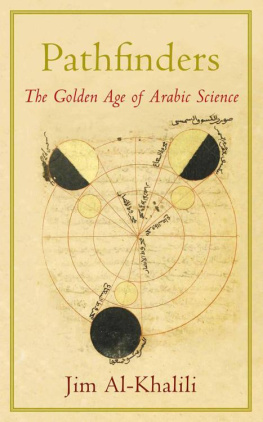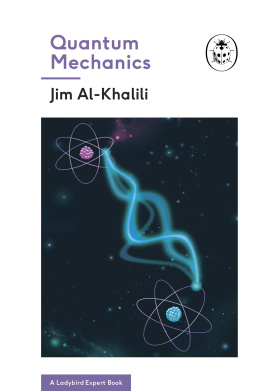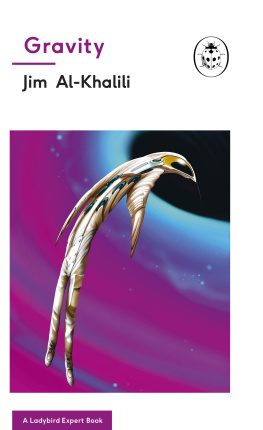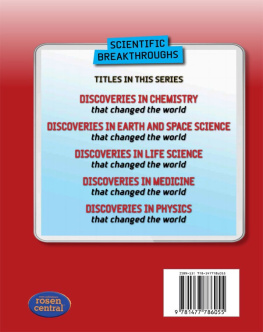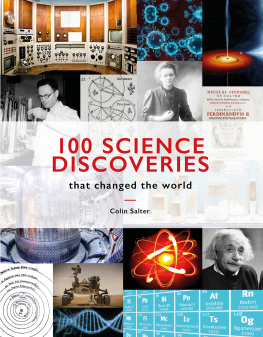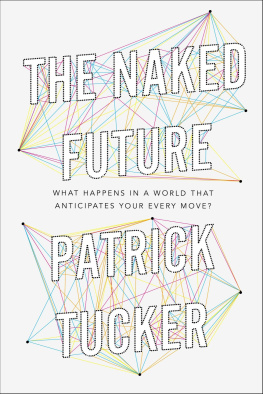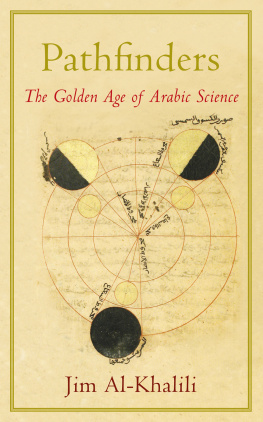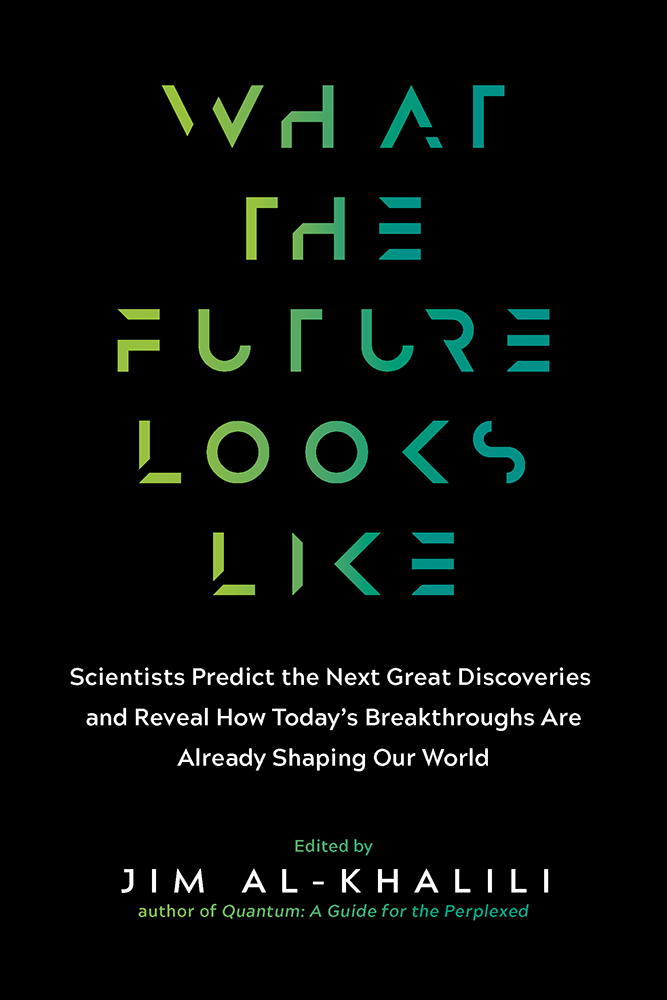

WHAT THE FUTURE LOOKS LIKE: Scientists Predict the Next Great Discoveries and Reveal How Todays Breakthroughs Are Already Shaping Our World
Selection, introduction, and Chapter 18 (Teleportation and Time Travel)
copyright 2017, 2018 by Jim Al-Khalili
Other chapters copyright of the author in each case 2017, 2018 by Philip Ball, Margaret
A. Boden, Naomi Climer, Lewis Dartnell, Jeff Hardy, Winfried
K. Hensinger, Adam Kucharski, John Miles, Anna Ploszajski, Aarathi
Prasad, Louisa Preston, Adam Rutherford, Noel Sharkey, Julia Slingo,
Gaia Vince, Mark Walker, Alan Woodward
Originally published in the UK as Whats Next? edited by Jim Al-Khalili 2017.
First published in North America by The Experiment, LLC, in 2018.
All rights reserved. Except for brief passages quoted in newspaper, magazine, radio, television, or online reviews, no portion of this book may be reproduced, distributed, or transmitted in any form or by any means, electronic or mechanical, including photocopying, recording, or information storage or retrieval system, without the prior written permission of the publisher.
The Experiment, LLC | 220 East 23rd Street, Suite 600 | New York, NY 10010-4658 |
theexperimentpublishing.com
Many of the designations used by manufacturers and sellers to distinguish their products are claimed as trademarks. Where those designations appear in this book and The Experiment was aware of a trademark claim, the designations have been capitalized.
The Experiments books are available at special discounts when purchased in bulk for premiums and sales promotions as well as for fund-raising or educational use. For details, contact us at .
Library of Congress Cataloging-in-Publication Data
Names: Al-Khalili, Jim, 1962- editor.
Title: What the future looks like : leading science experts reveal the
surprising discoveries and ingenious solutions that are shaping our world
/ edited by Jim Al-Khalili.
Other titles: Whats next? (London, England)
Description: New York : The Experiment, [2018] | Originally published as:
Whats next? / edited by Jim Al-Khalili (London : Profile Books, 2017). |
Includes bibliographical references and index.
Identifiers: LCCN 2017052652 (print) | LCCN 2017060642 (ebook) | ISBN
9781615194711 (ebook) | ISBN 9781615194704 (pbk.)
Subjects: LCSH: ScienceForecasting. | Technological forecasting.
Classification: LCC Q175 (ebook) | LCC Q175 .W546 2018 (print) | DDC 501dc23
LC record available at https://lccn.loc.gov/2017052652
ISBN 978-1-61519-470-4
Ebook ISBN 978-1-61519-471-1
Cover and text design by Sarah Smith
Manufactured in the United States of America
First printing April 2018
10 9 8 7 6 5 4 3 2 1
Introduction
Jim Al-Khalili
A ccording to Einsteins theory of relativity, the future is out there, waiting for usall times, past, present, and future, preexisting and permanent in a static four-dimensional space-time. And yet our consciousness is stuck in an ever-changing now, crawling along the time axis, welcoming the future as we gobble it up, then leaving it in our wake as it transforms into the past. But we are never able to see what is ahead of us. It is an incontestable fact that we cannot predict the future, despite the claims of psychics and fortune-tellers.
On a metaphysical level, whether our future is predestined or open, whether our fate is sealed in a deterministic universe or whether we have the freedom to shape it as we wish, is still a matter of debate among scientists and philosophers. Sometimes, of course, we can be reasonably confident what will happenindeed some future events are inevitable: the sun will continue to shine (for another few billion years anyway), the earth will continue to spin on its axis, we will all grow older, and the English soccer team I follow, Leeds United, will always leave me disappointed at the end of every season.
In other ways, the future can unfold in completely unexpected ways. Human culture is so rich and varied that very often events happen in ways no one could have predicted. So, while there will have been a few who foretold Donald Trumps US election victory in 2016, no one can (thus far) predict when and where the next big natural disastermaybe an earthquake or a floodmight strike.
Predictions about the way in which our lives will change thanks to advances in science and technology are spread across that wide expanse between the inevitable and the utterly unforeseen. The most reliable, and imaginative, soothsayers when it comes to conjuring up the future are usually science fiction writers, but how many of them before 1990 described a world in which the internet would connect all our lives in the way it does today? The World Wide Web still sounds fantastical when you stop to think about it.
So how does one compile a book, in the second decade of the twenty-first century, on what scientific advances are awaiting us, whether they are just around the corner, five years or ten years from now, or they are further off in the future, way beyond our lifetimes?
Some of the essays in this book serve as dire warnings about the way our world will be shaped, whether by nature or human activity, if we dont do something now. Solutions to our global problems will require financial, geopolitical, and cultural elements as well as scientific and engineering ones, but it is clear that harnessing our knowledge of the natural world, as well as the use of innovation and creativity in the technologies that exploit any new science, is going to be more vital than ever in the coming decades. So these essays are also beacons of hope, because they show how science can mitigate worst-case scenarios, such as the damaging effects of climate change, overpopulation, or the spread of pandemics through microbial resistance.
It is also undeniably true that the implementation of new technologies, whether in AI, robotics, genetics, geoengineering, or nanotechnology, to name but a few exciting current areas of rapid advancement, must be carefully considered and debated. We cannot afford to allow ourselves to be propelled headlong into an unknown future without carefully exploring the implications, both ethical and practical, of our discoveries and their applications. Many examples come to mind, such as the way robots are already beginning to replace humans in the workplace, how we can best guard against cyber terrorism, or the way we use up our natural resources while destroying habitats and threatening the ecosystem as the worlds population grows both in size and greed. But I am painting a bleak picture, and our future need not look like that.
It is important to remember that scientific knowledge in itself is neither good nor evilits the way we use it that matters. You can be sure that within a decade or two we will have AI-controlled smart cities, driverless cars, augmented reality, genetically modified food, new and more efficient forms of energy, smart materials, and a myriad of gadgets and appliances all networked and talking to each other. It will be a world almost unrecognizable from todays, just as todays world would appear to someone in the 1970s and 1980s. One thing we can say with certainty is that our lives will continue to be completely transformed by advances in our understanding of how the world works and how we harness it.
Some of the contributions in this book paint a relatively reliable picture of the future. This is because the science they describe is with us in embryonic form already and we can see clearly how it will mature in the years to come. Others offer more than one scenario describing how our future will unfold, not because we dont understand the science or because its application may throw up surprises, but because the path we take depends on how that scientific knowledge is used. These will be decisions we must make collectively as a society and that require responsible politicians as well as a scientifically literate populace.
Next page

